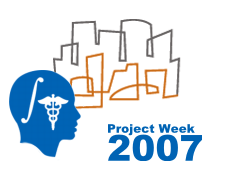ProjectWeek200706:CorticalThicknessForAutism
From NAMIC Wiki
Home < ProjectWeek200706:CorticalThicknessForAutism
 Return to Project Week Main Page |
Key Investigators
- UNC: Heather Cody Hazlett, Martin Styner, Clement Vachet
- MGH: Lilla Zollei
Objective
Our goal is to begin a longitudinal study of early brain development by cortical thickness in autistic children and controls (2 years with follow-up at 4 years). We want to be able to make statistical group comparisons.
Approach, Plan
Our approach is to locally compute the cortical thickness and establish local cortical correspondence in order to compare our populations.
Our plan for the project week is to learn how to use FreeSurfer in a pediatric age group, and run it on several cases. We would also like to use our itkEMS Tissue Segmentation tool to incorporate its results in the FreeSurfer pipeline. A study comparison between our CortThick tool and Freesurfer needs to be done to compare methods' reliabilities.
Progress
- Hans Johnson and Jeremy Bockholt worked with Clement to convert gipl t1 images into NIFTI for 4 cases. We used the ITK package ConvertBetweenFileFormats built into BRAINS2.
- Jeremy helped Clement convert NIFTI into the standard MGH format using mri_convert
- Jeremy helped Clement with how to set up freesurfer autorecon processes, several cases are running on the UNC system
- Clement with work with Jeremy to review the results of recon1 and recon2 on several cases before the end of the week
- Upon review, we have determined a need for a clean conversion between gipl and mgz, the method that we used above introduced incorrect orientation information in the nifti headers which when converted to mgz format caused the talairach registrations to fail. We have manually corrected three cases, but would benefit from a direct gipl to mgz tool with correct orientation preservation.